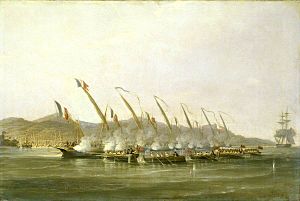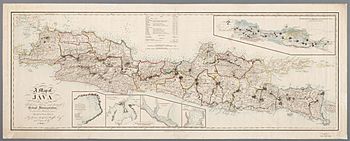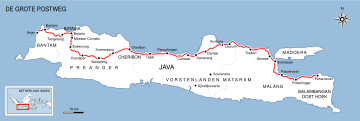French and British interregnum in the Dutch East Indies facts for kids
| 5 June 1806 – 19 August 1816 | |

Captain Robert Maunsell capturing French gunboats off Java, July 1811
|
|
| Preceded by | Dutch East Indies |
|---|---|
| Including |
Events:
Kingdom of Holland
Annexation by the First French Empire Invasion of the Spice Islands Invasion of Java Anglo-Dutch Treaty Dutch regained control over the Dutch East Indies from the British |
| Followed by | Dutch East Indies |
The French and British interregnum in the Dutch East Indies was a time when the Dutch East Indies (modern-day Indonesia) were ruled by France and then Britain. This period lasted from 1806 to 1816. France was in charge from 1806 to 1811. Then, Britain took over from 1811 to 1816. After that, control was given back to the Dutch.
This change happened because the French Empire took over the Netherlands. Also, the Dutch East India Company went out of business. These events led to big changes in how European colonies were managed in the East Indies. One of the Napoleonic Wars was even fought in Java. During these ten years, Java saw many changes. New roads and defenses were built. There were also battles, reforms, and big shifts in how the colony was run.
Contents
What Happened in the East Indies?
In 1800, the Dutch East India Company (VOC) went bankrupt. The Dutch government then took over all its assets. These included seaports, warehouses, forts, settlements, and plantations in the East Indies. This is how the Dutch East Indies became a Dutch colony. The main city was Batavia (now Jakarta). The Dutch controlled most of Java, along with parts of Sumatra, Malacca, the Moluccas, Celebes, and West Timor. Java was the most important area. This was because many valuable crops were grown there on Dutch-controlled farms.
Meanwhile, Europe was in chaos due to the Napoleonic Wars. These wars and revolutions changed the power balance among European empires. This also affected their colonies far away in Asia. In 1806, Napoleon Bonaparte took control of the Netherlands. He turned it into the Kingdom of Holland, which was like a puppet kingdom ruled by his brother, Louis Bonaparte. So, the East Indies became like a French colony, but managed by the Dutch.
The rivalry between France and Britain spread worldwide. It affected their colonies in the Americas, Africa, and Asia. Britain had already set up colonies in Bencoolen (Sumatra), Singapore, and Penang. Britain wanted to take over the rich Dutch colonies in the region. Because of this, the Dutch-controlled East Indies prepared for a British invasion.
French Rule (1806–1811)
|
French rule over the Dutch East Indies
|
|||||||||
|---|---|---|---|---|---|---|---|---|---|
| 1806–1811 | |||||||||
| Status | French colony administered through Dutch proxy | ||||||||
| Capital | Batavia | ||||||||
| Monarch | |||||||||
|
• 1806-1810
|
Louis I | ||||||||
|
• 1810
|
Louis II | ||||||||
|
• 1810-1811
|
Napoleon I | ||||||||
| Governor | |||||||||
|
• 1806-1808
|
Albertus H. Wiese | ||||||||
|
• 1808-1811
|
Herman Willem Daendels | ||||||||
|
• 1811
|
Jan Willem Janssens | ||||||||
| ISO 3166 code | ID | ||||||||
|
|||||||||
In 1806, King Lodewijk Napoleon of the Netherlands sent General Herman Willem Daendels to Java. Daendels was to be the new governor-general. His main job was to make Java's defenses stronger against a possible British attack. He arrived in Batavia (now Jakarta) in January 1808. He quickly started building new forces and roads. He also improved how the island was managed.
Daendels ruled with a firm hand. The colony was getting ready for the British threat. He built new hospitals and military barracks. He also set up new arms factories in Surabaya and Semarang. A new military college was built in Batavia. He tore down the old castle in Batavia and built a new fort at Meester Cornelis (Jatinegara). He also built Fort Lodewijk in Surabaya.
The Great Post Road
Daendels' most famous project was the Great Post Road (Jalan Raya Pos). This road stretched across northern Java from Anjer to Panaroecan. Today, parts of it are still used as the main road on Java. Some sections became part of the Jalur Pantura. This thousand-kilometer road was built in just one year. Sadly, thousands of Javanese people died during its construction due to the hard work.
Changes in Law and Religion
King Lodewijk, a Catholic, ended the old religious discrimination against Catholics. Before this, the Netherlands only favored Protestantism. Now, Catholics in the Dutch Indies could worship freely. This was mainly for European Catholics. This religious freedom was later continued by Stamford Raffles.
Daendels admired French culture. He built a new governor-general's palace in Batavia. It looked like a smaller version of the Château de Versailles. This palace is now the Ministry of Finance office. He also changed the name of Buffelsveld (buffalo field) to Champs de Mars (now Merdeka Square). Daendels also made the Continental Law system the official law in the Dutch East Indies. This legal system is still used in Indonesia today.
Relations with Local Rulers
Daendels was very strict with the local Javanese rulers. This made them willing to work with the British against the Dutch later on. He also made the people of Java do forced labor, called Rodi. There were some rebellions against this. He also ended the Banten Sultanate. In 1808, Daendels told Sultan Aliyuddin II of Banten to move his capital. The Sultan refused. In response, Daendels invaded Banten and destroyed the Surosowan palace. The Sultan was arrested and sent away. Daendels then declared that the Banten Sultanate was now part of the Dutch East Indies.
British Rule (1811–1816)
|
British rule over the Dutch East Indies
|
|||||||||
|---|---|---|---|---|---|---|---|---|---|
| 1811–1816 | |||||||||

A map of Java: Chiefly from surveys made during the British administration constructed in illustration of an account of Java by Thomas Stamford Raffles
|
|||||||||
| Status | Crown colony | ||||||||
| Capital | Batavia | ||||||||
| Monarch | |||||||||
|
• 1811-1816
|
George III | ||||||||
| Governor | |||||||||
|
• 1811
|
Robert Rollo Gillespie | ||||||||
|
• 1811-1816
|
Stamford Raffles | ||||||||
|
• 1816
|
John Fendall Jr. | ||||||||
| ISO 3166 code | ID | ||||||||
|
|||||||||
In 1809, the British Governor of India, Lord Minto, wanted to take over the valuable Spice islands. The East India Company knew that controlling these islands would hurt Dutch and French trade. It would also give Britain control of the rich spice trade. These islands would also be a good base to conquer Java. By August 1810, the British had captured the islands of Banda Neira, Ambon, and Ternate with little trouble.
Stamford Raffles in Charge
In 1811, Java was captured by a British force led by Lord Minto. He then appointed Sir Thomas Stamford Raffles as the lieutenant governor of Java. Raffles continued to centralize the administration, just as Daendels had started. He planned to divide Java into 16 regions. He changed the Dutch way of managing things. He also made land ownership rules more flexible and expanded trade. Raffles tried to bring in new economic ideas and stop forced farming in Java.
Raffles lived at Buitenzorg. Even though he had a small team of British senior staff, he kept many Dutch civil servants in the government. He also made peace agreements and led military trips against local Javanese princes. One important event was the attack on Yogyakarta in June 1812. Yogyakarta was one of the most powerful local kingdoms in Java. During the attack, the Yogyakarta palace was badly damaged. Raffles took many important documents from the court's archives. This was a big deal in Javanese history. It was the first time a local court had been captured by a European army. This greatly embarrassed the local leaders. Raffles also sent an expedition to Palembang in Sumatra. His goal was to remove the local sultan, Mahmud Badaruddin II, and take Bangka Island. This would help Britain establish a permanent presence there. Besides Javanese court archives, Raffles also sent Javanese artifacts to Lord Minto. These included a Buddha head from Borobudur and two large ancient stone inscriptions.
Raffles and Javanese Culture
Raffles was very interested in the history, culture, and people of Java. During his time in charge, British Java saw a rise in archaeological studies. The government paid more attention to local culture, art, and history. His administration rediscovered the ruins of the great Buddhist temple of Borobudur in Central Java. Other ancient sites in Java, like the Prambanan Hindu temple and the old Majapahit city of Trowulan, were also found during his rule. With Raffles' support, many ancient monuments in Java were rediscovered, dug up, and carefully listed for the first time. Raffles was very enthusiastic about the island's history. He wrote a book called History of Java, which was published in 1817.
In 1815, Java was given back to the Netherlands. This happened after the Napoleonic Wars ended, as agreed in the Anglo-Dutch Treaty of 1814. By 1816, the Dutch had full control of their colony in Java and other parts of the archipelago. They then began to conquer other independent areas in the region. By 1920, they had fully established their colonial state in the Indonesian archipelago. The Dutch East Indies became one of the most profitable European colonies in history.





